We declare ART
a GATS FREE ZONE
Nous déclarons l'ART
ZONE HORS AGCS
Commons Service Group
Nous sommes un collectif de curateurs agissant sous le nom de Commons Service Group pour développer une information sur l'Accord Général sur le Commerce des Services (AGCS) et ses conséquences pour le champ de l'art et de la culture. Nous soutenons la libre circulation des connaissances et des productions artistiques et culturelles. As a collective of curators, we have given ourselves the two-fold mandate of informing the contemporary art field about the significance of the General Agreement on Trade in Services (GATS) for art and cultural production, and sharing knowledge about projects that oppose the commercialization of culture.
Artistes participants : Lara Almárcegui (Pays-Bas), Etienne Cliquet (France), Maura Doyle (Canada), Claude Lévêque (France), Chris Lloyd (Canada), public works (Royaume-Uni), Antje Schiffers (Allemagne), et YOUNG-HAE CHANG HEAVY INDUSTRIES (Corée)
Le Commons Service Group a invité les artistes à créer une oeuvre sur une page A5. Sur l'autre face, il a déclaré « l'Art Zone Hors AGCS ». La série « d'inserts » résultants a circulé dans une sélection de publications gratuites de l'art contemporain. The Commons Service Group invited each artist to create a work for an A5 page. On other side the Commons Service Group declared "Art a GATS Free Zone". The resulting series of A5 "inserts" circulated in a selection of free contemporary art publications.
Participating publications: l'art même (Belgium), Fucking Good Art (Netherlands), Hors d'Oeuvre (France), multitudes.samizdat.net (France), NERO (Italy), republicart.net & eipcp.net (Europe), samplesize.ca (Canada), Variant (Uk), and Zehar (Spain)
Le Commons Service Group a défini des ZONES HORS AGCS à la Biennale de Venise pendant l'ouverture professionnelle (7-13 juin) avec un kiosque mobile conçu pour l'occasion par le collectif d'artistes/architectes public works. The Commons Service Group established GATS FREE ZONES at the Venice Biennale during the professional opening (7-13 June) with a mobile kiosk designed for the occasion by artist/architect collective public works.
Commons Service Group - 2005
Heather Anderson, Jerome Grand, Julia Maier
‡‡‡‡‡‡‡‡‡‡‡
Le Commons Service Group est l'identité collective que nous avons créée. La devise « Committed to building the commons through serving art, artists and audiences » décrit ce qui nous rallie : l'idée que l'Art et la Culture sont communs et d'intérêt général et public. Nous défendons le libre accès à la production artistique, et c'est par le biais d'une étude sur la propriété intellectuelle que nous avons pris connaissance que l'Accord Général sur le Commerce des Service (AGCS) peut réduire -voire anéantir- l'espace public.
Nous ne pouvons pas laisser à l'OMC ou l'UNESCO le soin de décider du destin de la production artistique et culturelle alors que nous voulons agir professionnellement sur ces questions. D'horizons différents, nous sommes tombés d'accord pour entreprendre des recherches sur le « commun », le bien public et l'AGCS, et de faire un projet curatorial pour restituer le fruit de nos recherches.
Le projet est un ensemble d'actions, produites en fonction de situations externes ou internes au groupe. Il nous a été nécessaire de travailler sur les mots : dissémination, kiosque, information, inserts, « Zone Hors AGCS », « inservention », « manoeuvres esthétiques », pour parler de la position curatoriale et particularité matérielle de ces situations.
... manoeuvres esthétiques / aesthetic manoeuvres...
Nous aimons parler de « manoeuvres esthétiques », par là, nous entendons : développer des stratégies de mise en circulation d'une information politique par des moyens artistiques. Notre groupe s'est déplacé à Londres, Paris ou Venise. Nous y avons rencontré des artistes, critiques, auteurs, distribué des « kits d'information », des badges déclarant l'art Zone Hors AGCS, mis en circulation des « inserts » créés avec des artistes dans des revues d'art gratuites...
De même, le concept d' « inservention » situe le projet moins dans l'interventionnisme que dans une logique de glissement dans des structures existantes, comme celles de la biennale d'art contemporain de Venise, des revues gratuites partenaires du projet.
Inservention = insert + service + intervention
Nous sommes entrés dans la biennale de Venise au moment où des acteurs de l'art contemporain, venant du monde entier, se regroupent pour les journées professionnelles (l'AGCS est un accord signé par 146 nations). Nous avons déclaré la biennale et la ville de Venise «Zones Hors AGCS ». Nous avons demandé à public works, collectif d'architectes et d'artistes, de concevoir le kiosque que nous avons réalisé. La difficulté à faire circuler l'information dans le champ de l'art en a inspiré la forme -trois blouses de travail équipées, sur leurs revers, de poches contenant des « inserts » et, des badges, donnés de la main à la main- et l'usage : activer le kiosque par une série de « chorégraphies ».
Avant Venise, certaines publications d'art gratuites ont été pressenties, à l'instar des artistes, comme partenaires du projet. Nous les avons sollicitées pour qu'elles deviennent le véhicule des travaux artistiques et de l'information sur l'AGCS. Pourquoi ? Parce que la plupart de celles que nous avons choisies sont issues de collectifs et que leurs activités reposent principalement sur des subventions publiques. Via les inserts, nous voulions engager avec elles une discussion sur la libre circulation des biens immatériels, connaissances et créations artistiques et, d'une façon générale, apporter une information aux acteurs du champ de l'art.
Nous avons considéré dans ce contexte que l'information était un objet à traiter autant sur le plan politique qu'esthétique. Par exemple, l'esthétique du projet nous a été inspirée par le logo « Zone Hors AGCS » -un emprunt. Dans la société, la lutte contre l'AGCS s'exprime, entre autres, par la déclaration de zones « Hors AGCS ». Un logo lui est attaché et existe en huit langues. Aujourd'hui, plus de 1000 collectivités, à travers le monde, se sont proclamées, par la voie de votes réguliers, ZONES HORS AGCS. Touchés par la dimension essentiellement symbolique de ces actions, nous avons adopté le logo « Zone Hors AGCS » et décidé son déplacement vers des « zones » relevant de l'immatériel et aux contours plus fluides du territoire de l'art. Nous avons dessiné tous les outils visuels du projet : notre site web, notre dossier de presse... - et repris une esthétique existante : celle des ONG.
Nous avons choisi des artistes qui, d'après nous, par leurs pratiques contribuent à l'enrichissement du « commun ». Nous les avons informés de nos intentions, puis nous avons sollicité leur participation au projet en leur proposant une « cohabitation ». Nous avons créé des « inserts », feuillets libres de format A5. Sur une face, les artistes interviennent ; sur l'autre face, nous apportons de l'information. Ces deux faces sont donc connectées sans être assujetties l'une à l'autre.
Julia pour le Commons Service Group
‡‡‡‡‡‡‡‡‡‡‡
In response to the WTO's empire, we recommend art. In inviting artists to participate in the Art is a GATS Free Zone project, we were specifically interested in art practices that directly address a public through opening up the possibility of exchanges--art practices more concerned with creating a situation of interaction than with creating a commodity object. For it is art's value within the public sphere--and the very of concept of the Commons, comprising public services--that is undermined by the "free-market" agenda of the GATS.
Lara Almárcegui often undertakes projects to reclaim abandoned urban sites for public use. In Repair and Occupy an Abandoned Boat (2003), Almárcegui occupied public space as an artist, rendering a public service through acts of restoration. Antje Schiffers continues her practice of exchanging the production of art for subsistence in the project The main thing is you've got work (2003). Schiffers created a position for herself as company artist at tire manufacturer ContiTech, proposing to carry out all services that the staff thought appropriate for a company artist.
The Commons Service Group is interested in how artists use the web as an accessible space of public address and as a means of la mise en commun . Almost all of the artists participating in this project employ the Internet both as a medium in itself and/or as a way to communicate projects that exist in other forms. Chris Lloyd has been writing (almost) daily letters to Canada's Prime Minister since January 2001, publishing his correspondence on his Dear PM blog since August 2003. YOUNG-HAE CHANG HEAVY INDUSTRIES works almost exclusively on the web, publishing their works in multi-lingual versions. For this project, YOUNG-HAE CHANG HEAVY INDUSTRIES humorously translated their Monaco -font aesthetic to a printed chant against the GATS. In our research, we came across " Lisible " , a text Etienne Cliquet had written on the GATS' consequences for artists. Cliquet works in the digital realm where the concept of putting into common offers strategies of resistance to the increasing attempts to privatize knowledge and immaterial goods. Cliquet's proposal for a secret code reflects just the kind of emergency measures required up against global corporations. Maura Doyle continues her penchant for mail order with her offer to send, for free, Sticks made from dead people. Collected from Mount Pleasant Cemetery in Toronto, Doyle's work is literally gathered from the res commun . Claude Lévêque, the most established and senior artist participating in this project, appropriates a very identifiable brand mark on a t-shirt to make a rather wry statement about the ambiguity of the wearer's engagement.
The Commons Service Group approached public works because we esteem the ability of their art and architecture collaboration to catalyze public response and interaction within a particular context. Public works' answer to our request for a mobile "kiosk" enabled us to insert ourselves into the Venice Biennale and its surrounding events in order to carry out our itinerant services. While we consider the Art is a GATS Free Zone project to have succeeded at a micro-political level in raising awareness about the significance of the GATS for contemporary art and cultural production--a discussion that has been largely non-existent in a field that coolly avoids political and economic issues--it is another question whether art and cultural production will be able to counter the global impulse toward cultural capitalism. G-A-T-S HAS TO GO!
"One of the earliest distinctions between goods production and service provision, made by Adam Smith, relates less to the tangible or intangible character of the product of labor than the social character of labor itself: whether or not that labor produces profit . For Smith, a service is a product that contains only use value and no exchange value: it adds "to the value of nothing."[1] It may have been precisely this condition--which rendered services suspect for Smith--that the artists of the AWC aspired to in considering their work intellectual property...It may be from this perspective one can understand how artists of the late 1960s saw in the condition of service products, relations, positions, and functions a means of protection from, and even resistance to, forms of exploitation (of themselves and others) consequent to the production and exchange of cultural commodities" ( Fraser 1996). 1. Smith, Adam. The Wealth of Nations , quoted in Delaunay and Gadrey, Services in Economic Thought, 12, in Fraser, 1996. |
The GATS designates art and culture as "services", encapsulating them within the category "Recreational, cultural and sporting services". Within the GATS framework, art production and art's professional practices are conceived of as services/commodities, indistinguishable from any other services/commodities within a global market. By extension, artists and other art professionals, become "service providers".
Writing in the 1990s, Andrea Fraser outlines the analysis initiated in the 1960s of artistic practice as heteronomous--that is subject to external laws or rules, particularly economic forces. Many artists developed strategies aimed at undermining the object/commodity status of the artwork, such as "site specificity and institutional critique, conceptual art, and cultural activism". The Art Workers Coalition Open Hearing (1969) demands for artists' proprietary rights over their work, recognized art's tangible and intangible value, in turn redefining artwork from a commercial product or good to a service product--in this case intellectual property (Fraser 1996).
The conceptualization of art practice as a service was central to Fraser's own practice in the 1990s in her development of "project work," often comprising the "appropriation of professional models in rejection of traditional studio practice." Fraser outlines how the term "service" encapsulates the diversity of project work practices (in terms content and approaches) and aims to identify the "economic condition of project work as well as the nature of the social relations under which it is carried out." The increasing practice of cultural institutions paying fees to artists underscores the emergence of art as "service provision": congruously "a fee is by definition payment for services" (Fraser 1994).
"I would say that these questions are not exclusive to project based practice--defined as a service or not. Project based practice simply makes it necessary to pose them. I would say that we are all always already serving. Studio practice conceals this condition by separating production from the interests it meets and the demands it responds to at its point of material or symbolic consumption. As a service can be defined, in economic terms, as a value which is consumed at the same time it is produced, the service element of project based practice eliminates such separation . An invitation to produce a specific work in response to a specific situation is a very direct demand, the motivating interests of which are often barely concealed and difficult to ignore. I know that if I accept that invitation I will be serving those interests--unless I work very hard to do otherwise" (Fraser 1994). |
But as Fraser points out, while "artistic appropriation of forms of representation, production, or organization from corporate culture may have begun as a critical strategy"..."entering into competition with that culture, for artists no less than museums, implies not only an acceptance of but also an investment in the stakes offered up as legitimate and desirable by that culture" (Fraser 2003: 119-120). This current state of affairs is crucial to examine in light of the present GATS negotiations and applications: the concept of service provision--what is/was a critical and pragmatic strategy by artists and public institutions--has emerged to reduce art and cultural production to solely economic terms, seeking to force art--and other publicly funded services from education to health to water--to compete like any other offered on the global capitalist market.
A professionalizing shift within the art world generally, in hand with the increasing corporatization of public cultural institutions--both in management structure, and, for example, an emphasis on marketing strategies and demands to justify programs in terms of revenue, or new audience development--reflects, as Jim McGuigan argues, how public cultural policy is being tailored to a neo-liberal agenda. The GATS is co-extensive with such cultural policy that rationalizes spending decisions on the basis of economic rather than cultural value. Fraser suggests that due to escalating capitalist pressures, artists and art professionals are beginning to recognize their activities as in competition with commercial entertainment and commodity culture (Fraser 2003: 119; McGuigan 2004).
In Fraser's terms--and similarly in those of the GATS--any artist's practice can be considered to be a service in so far as s/he is creating a work that will meet certain demands "at its point of material or symbolic consumption" (Fraser 1994). As curators approaching artists to participate in this project, we were conscious of how the notion of "service" could be applied both to the artists' response in producing a work, and to our own role as curators. We first undertook to inform the artists about the significance of the GATS for contemporary art production. In our own production, we treated information as an object for both aesthetic and political engagement. Realizing our commitment to "building the commons through serving art, artists, and audiences", we literally wore the project in order to disseminate the artists' works and information to audiences in Venice.
Heather for the Commons Service Group
References
Fraser, Andrea (2003). "A Museum Is Not A Business, It Is Run In A Businesslike Fashion,"
Beyond the Box: Diverging Curatorial Practices , (The Banff Centre Press): 109--122.
Fraser, Andrea (1996). "The Critique Of Artistic Autonomy"
http://seminare.snm-hgkz.ch/~yvonne/seminare/SAEULE_PCode/fraser4.htm
Fraser, Andrea (1994). "How To Provide An Artistic Service: An
Introduction" http://home.att.net/~artarchives/fraserservice.html
McGuigan, Jim (2004). Rethinking Cultural Policy (Berkshire: Open University Press)
‡‡‡‡‡‡‡‡‡‡‡
Creative Commons: an alternative to copyright/droits d'auteur. In December 2004, at the Creative Commons Belgian Launch Event in Brussels, Séverine Dussollier's keynote address put into a historical perspective the progression of authorship (1). Aggravated by the contemporary twist that has turned copyright (droits d'auteur in French) from a protection for creators to a tool for juridical control today, she reminded listeners that first and foremost copyright laws exist for authorization purposes -- to authorize and forbid -- not for profit reasons. The development of laws to protect authors originated in the 18th century, a period of history that emphasized progress through collective sharing (e.g. the encyclopedia) and recognized the bond between creator and creation. Copyright laws were established to encourage creative progress by: 1) recognizing the work of creators, permitting them to pursue their work and 2) allowing culture to be part of public wealth, opening circulation and usages. In other words, these laws were established as a balance between two needs: to reward creativity and to allow new work to build upon the past.
However, due to the progress in reproduction technologies and the development of cultural industries, this balance has been shifting. The laws that were written to maintain this balance have been reinforced to serve economic interests and regulate technological use. Certain discourses parallel intellectual property with private property, defining knowledge and culture like any other property. With copyrights regulating more and more usages, an unfair balance between copyright-holders and users, past creativity and new creativity is established. It is creating the rhetoric of "users as pirates" while diminishing free culture. The tool that was initially developed for authors as a possible protection, is now automatically applied to any creation (except if the author states otherwise) and often stops profiting the creators as it enters the juridical world (2).
Appalled by these problems, Séverine Dusollier emphasized the need for a reliable alternative that continues to protect the creators and moderates the gluttony of today's copyrighting system. It is in Creative Commons that she sees a possibility for change because it is a rethinking of copyright that continues to protect creators and it promotes the sharing of culture and knowledge. This re-establishes a balance needed for the building of the commons (3).
This was the conclusion we adopted for the Commons Service Group: all of our research, as well as the entirety of our project is under Creative Commons licenses. Our decision to adopt Creative Commons is essential in the conceptual framework of our projects and our ever growing preoccupations with the increasing privatization of human resources and interaction through the GATS and its relative the TRIPS (Trade-Related Aspects of Intellectual Property Rights). The TRIPS is another WTO agreement that outlines a global standard for intellectual property -- from copyrights to patents. It was in reaction to this debate on intellectual property that the necessity to use an alternative became clear.
Considering that all productions automatically fall into a full copyright (all rights reserved), it was necessary to find an alternative that is better adapted to the mediums we are using (web & ephemera), that promotes a new idea of authorship (some rights reserved), and that nourishes the commons (free culture). We investigated other alternatives to copyright, including Copyleft and the Licence Art Libre (4). In the end, we chose Creative Commons for its flexibility and availability. First, the variety of licenses are better suited to our work with the artists of the project. We asked each artist to consider the alternative and choose according to his/her own needs a specific license for the work produced in this project. Second, it is a system that has been adapted to the jurisdictions of twenty-two countries (and the number keeps growing) which makes it a more reliable and recognizable system to use internationally.
The Commons Service Group participated in the project RESSOURCES, a series of events and workshops on Open Source and intellectual property that took place during the 11th, 12th and 13th of April 2005 at E.V.E., a cultural association in the Grenoble university system. The workshops and public presentations brought together Florian Schneider, Aris Papathéodorou, Videobase, Christine Tréguier, Florent Latrive and students from several art schools in the region to engage in problematics around intellectual property and usages of Free/Libre Open Source Software (FLOSS) (5). We presented and discussed alternatives to copyright, promoting Creative Commons Licenses, which were translated for the French jurisdiction in November 2004. To promote these licenses and enter into discussions with the participants of the workshop, we produced a series of pin-back buttons that displayed the Creative Commons logo and its four different deeds. Each button was attached to an A5 leaflet, which described the licensing system and its relevance as a form of opposition to the increasing privatization of culture and art. During distribution, we engaged in a discussion with each recipient, explaining the significance of the buttons. Following the exchange, people were free to wear the button and were able to tell others about the movement behind the symbol. This same approach to the dissemination of information was later repeated in Venice. It partly defines what we mean when talking about "aesthetic maneuvers."
Jerome for the Commons Service Group
(1) Séverine Dusollier is Head of the Department of Intellectual Property Rights at the Research Center for Computer and Law at the University of Namur, Belgium.
(2) Two references are invaluable aids in understanding this shift in copyright and intellectual property:
In English: Free Culture - Lawrence Lessig. Download for free: http://www.free-culture.org/
En français: Du Bon Usage de la Piraterie - Florent Latrive. Télécharger gratuitement : http://www.freescape.eu.org/piraterie/
(3) Creative Commons is a legal and more flexible alternative to the traditional copyright/droit d'auteur. It allows creators to choose which rights they retain and which they leave open. Developed in 2002 by Professor of Law Lawrence Lessig for the American Legal system, creative commons is being translated into the legal system of countries across the globe. To better understand how it works, please refer to their website where you will find all the information necessary: http://creativecommons.org
(4) An important collection of texts on the subject of copyleft and the free, in French (En français): Libres Enfants du Savoir Numérique - Olivier Blondeau & Florent Latrive éditeurs. Available for free: http://www.freescape.eu.org/eclat/
(5) For more information about the RESSOURCES workshop and its participants: http://ressources.samizdat.net
‡‡‡‡‡‡‡‡‡‡‡
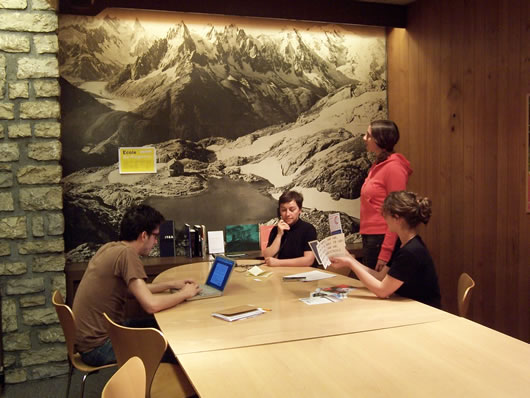 Le
Commons Service Group au travail à l'Ecole du MAGASIN. The Commons
Service Group at work in the Ecole du MAGASIN. photo: Frédéric Besson
Le
Commons Service Group au travail à l'Ecole du MAGASIN. The Commons
Service Group at work in the Ecole du MAGASIN. photo: Frédéric Besson
Le Commons Service Group est basé à l'Ecole du MAGASIN - Centre National d'Art Contemporain de Grenoble (France). L'Ecole est une des activités du Centre d'Art qui l'héberge. Chaque année, sur une période de dix mois, une petite équipe recrutée sur concours est formée aux pratiques curatoriales au travers de la réalisation d'un projet.
The Commons Service Group is based at the Ecole du MAGASIN, an international curatorial training program at the Centre National d'art Contemporain in Grenoble (France). The Ecole is part of the MAGASIN's programming, and for ten months each year hosts a small team of participants selected through an application process.
http://www.ecoledumagasin.com/
Ecole du MAGASIN
MAGASIN-CNAC
site Bouchayer-Viallet
155, cours Berriat
38028 Grenoble, cedex 1 France
The Commons Service Group's work is under Creative Commons Attribution-Share Alike license.
http://creativecommons.org/licenses/by-sa/2.5/
Commons Service Group
Committed to building the commons through serving art, artists, and audiences.
Heather Anderson
Jerome Grand
Julia Maier
commonsservicegroup@gmail.com
![]()
version web du depliant
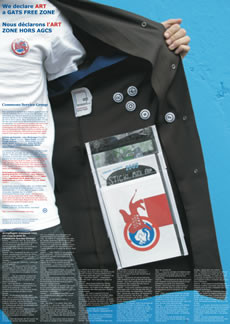
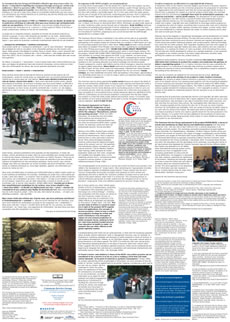
Extraits de conversation entre les membres du Commons Service Group et Nicolas Audureau (assistant de la Librairie du MAGASIN)
Nicolas : Vous pouvez m'expliquer comment vous est venu le nom de Commons Service Group ?
Heather : Commons vient de notre recherche sur l'économie du don et sur la gratuité. Le Commons est l'idée d'une base de données partagée par une communauté ou une société, et se rattache à la chose publique.
Jerome : Dans l'économie du don, il y a une relation asymétrique entre celui qui donne et celui qui reçoit. Alors que la mise en commun c'est « comment l'on donne à partager ».
Julia : Le concept de « communs » relève de l'intérêt général...
Jerome : ... c'est ça qui tisse le lien social. Par exemple, sur Internet, des artistes, des auteurs mettent leurs travaux dans le pot commun et favorisent la circulation de leurs créations.
Heather : ... oui, sur Internet, le stock est illimité et peut être dupliqué. Internet est un modèle pour la mise en commun de biens immatériels.
Julia : notre devise est « Committed to building the Commons through serving art, artists and audiences ». C'est notre contexte de travail et nous sommes solidaires des mouvements du libre et Open Source.
Nicolas : La circulation libre des idées...
Julia : Oui, le Commons Service Group offre le service de promouvoir les outils de la mise en commun, comme les licences Creative Commons. Nous nous intéressons aux pratiques des artistes qui adressent des services gratuits au public.
Heather : Dans ses écrits, Andrea Fraser parle du contexte de travail des artistes qui font des projets pour les institutions publiques et propose la notion « artistic services ».
Jerome : Dans les années 60-70, à partir de la notion de service, des artistes développent une stratégie pour échapper à la marchandisation des objets de l'art.
Julia : Et l'AGCS se réapproprie cette idée de l'artiste producteur de service en réduisant la culture en échange de services culturels ! Il y une grande différence entre les services offerts par des artistes dans l'intérêt général et la notion de service dans l'AGCS.
Nicolas : ... avec l'AGCS, on est parvenu à cette conclusion : les biens matériels et immatériels peuvent être traités de la même manière.
Julia : Oui, tous les services peuvent être régulés de la même manière que des marchandises - il n'y a plus de distinction entre services publics et services marchands.
Heather : Selon Andrea Fraser, les productions artistiques doivent être reconnues comme des services professionnels et être rémunérés.
Julia : Dans notre projet, il était important de rémunérer les artistes et de les reconnaître comme des professionnels et experts dans leur propre champ.
Heather : Si l'art est un service, c'est aussi qu'une grande partie du travail n'est pas visible et ne débouche pas toujours sur une production matérielle.
Jerome : ... les artistes doivent être soutenus matériellement pour que l'art circule librement...
Nicolas : ... et cela rejoint l'idée du commun...
Julia : Les mots « circulation libre, libre circulation », « services » sont utilisés par l'OMC comme par les mouvements du libre et dans des sens presque opposés.
Jerome : Parlons de notre groupe et de notre collaboration. En tant que collectif de curateurs, nous offrons des services pour le champ de l'art.
Julia : Pour ça nous avons créé un groupe qui prend en charge la part d'information sur l'AGCS et la traite pour le champ artistique. Nous nous sommes construit une identité à travers le développement d'un graphisme particulier basé sur l'emprunt du logo « Zone Hors AGCS », d'abord pour notre site web - notre première présence publique.
Jerome : Nous avons choisi des formes éphémères, mais propices à diffuser de l'information. Les inserts et les badges sont les marqueurs des idées que nous voulons communiquer.
Julia : ... les inserts exposent à la fois l'information et le travail des artistes. Nous avons occupé une face de l'insert pour déclarer « l'Art Zone Hors AGCS » et invité les artistes à travailler librement, sur l'autre face. C'est comme ça que nous avons reçu des propositions grinçantes et humoristiques.
Jerome : ... ce projet est disséminé à travers plusieurs supports, géographies et temporalités...
Heather : ... pour donner une cohérence à ce projet, nous avons reproduit et décliné toujours la même esthétique.
Nicolas : Est-ce que l'esthétique que vous avez choisie a suscité des réactions ? A-t-elle été à l'origine de discussions ? Est-ce un médium pour des rencontres et des échanges ?
Heather : Quelqu'un m'a dit qu'elle aime cette esthétique parce qu'elle est très laide !
Jerome : Oui, elle a quelque chose de très fonctionnel. Elle évoque tout de suite le politique et l'informationnel.
Heather : C'est pareil, quand tu tombes sur notre page web, tu ne sais pas très bien à qui tu as à faire, une association, une ONG ?
Julia : ça permet, peut-être, de repenser le rôle des curateurs, des artistes... Cette esthétique atypique est, de fait, le médium de nos rencontres. Elle est reproduite jusque dans le kiosque...
Jerome : ... le kiosque, c'est trois blouses de travail transformées en présentoirs... Au sujet du graphisme, il est basé sur le logo « Zone Hors AGCS » qui définit un travail en deux couleurs. Nous avons proposé aux artistes de travailler aussi avec deux couleurs, mais celles de leurs choix. Pour le formatage, nous nous sommes inspirés du web et choisi Verdana et Georgia, deux polices de caractère créées pour le web dans les années 90.
Julia : ... tous nos contacts et relations avec les participants du projet ont eu lieu sur le web comme une grande partie de nos recherches.
Heather : Il est important de dire qu'en tant que curateurs nous sommes auteurs d'une esthétique qui porte une information.
Nicolas : Est-ce que vous avez trouvé un terrain favorable dans le champ de l'art contemporain pour la réception de ce projet ?
Julia : Déjà, nous avons trouvé un soutien dans les partenaires du projet. Ils ont été réceptifs à l'information que nous leur apportions et s'en sont fait le relais. A Venise, nous avons été plutôt bien reçus par ceux vers qui nous sommes allés...
Heather : ... ces personnes se sont intéressées, elles seront plus attentives à ces questions-là. Nous en avons aussi rencontrées qui étaient vraiment réticentes à la dimension politique du projet... le politique, c'est pas sexy !
Julia : D'accord, mais les activités du Commons service Group reposent sur des critères précis.
Nicolas : Quels sont ces critères ?
Julia : « construire le commun en servant l'art, les artistes et le public de l'art », ça détermine, d'emblée, un cadre de travail ... Ce groupe est attentif aux mesures qui contraignent la libre circulation des productions artistiques.
Jerome : Il faut placer le travail sous des licences Creative Commons, nous les avons choisie parce qu'elles s'adaptent bien aux pratiques artistiques.
Heather : Un projet du Commons Service Group doit porter un regard critique sur la société contemporaine. A partir du mois d'août, nous nous séparons géographiquement, mais il reste un espace actif entre nous, les artistes et le public de l'art, c'est le blog.
Jerome : ... au coeur de toutes nos activités, il y a le web. Nous continuerons de travailler à distance et en réseau - Florian Schneider a bien illustré cette économie de travail, « Friendship without friends » -une amitié sans amis-.
Julia : Et puis nous pourrons créer d'autres branches...
Heather : ... développer des projets, avec de nouveaux membres, sous l'identité du Commons Service Group...
‡‡‡‡‡‡‡‡‡‡‡
Dans sa rédaction, l'AGCS réduit
« culture, art » à « services culturels » et les place sous la nomenclature « Services récréatifs, culturels et sportifs ». Vue sous cet angle, la production artistique devient un service/marchandise comme un autre dans le marché global. Par extension, les artistes et autres professionnels de l'art deviennent des « producteurs de services » parmi d'autres.
L'exercice professionnel dans le champ de l'art est bouleversé par l'accroissement des corporatisations dans les institutions culturelles publiques. De plus en plus d'institutions doivent justifier leur choix et leur programmation selon des critères de rentabilité ou d'ouverture à de nouveaux publics. Cette situation reflète à quel point, comme l'écrit Jim McGuigan, les politiques culturelles publiques sont progressivement adaptées pour entrer dans l'agenda néo-libéral. Dans le cadre des décisions et orientations des politiques culturelles, l'AGCS impose que la valeur économique prime sur la valeur culturelle. D'après Andrea Fraser, sous les pressions capitalistes, les artistes et professionnels de l'art prennent conscience que leurs activités entrent désormais en compétition avec les industries de divertissement et la culture marchande...
‡‡‡‡‡‡‡‡‡‡‡
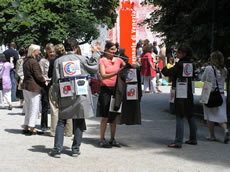
Définir des Zones hors AGCS à la Biennale de Venise, 9-13 juin, 2005.
Establishing GATS Free Zones at the Venice Biennale, June 9-13 2005.
photo: Aaron Schmidt
This logo originated with the French movement against the GATS and has now been adopted in many countries. Numerous local, municipal, regional and departmental governments have passed resolutions declaring their territories "GATS FREE ZONES". Download the logo in 8 languages:
http://horsagcslogo.chez.tiscali.fr/download.html
Ce logo est attaché à la lutte contre l'AGCS. Ce mouvement, d'origine française, se déploie en de nombreux points à travers le monde et de nombreuses collectivités se sont déclarées
« Zones Hors AGCS ». Vous pouvez télécharger le logo en huit langues sur:
http://horsagcslogo.chez.tiscali.fr/download.html
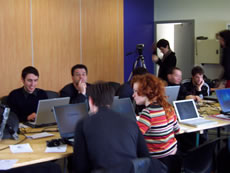
Projet RESSOURCES, 11-13 avril 2005. Project RESSOURCES, 11-13 April 2005. photo: Aaron Schmidt

Entretien avec l'économiste Liliane Bensahel, chargée de mission auprès
du Vice-Président des relations internationales, Espace Europe,
Université Pierre Mendes France, Grenoble. Meeting with economist
Liliane Bensahel, International Relations, Espace Europe,
Université Pierre Mendes France, Grenoble. photo: Julia pour le Commons
Service Group
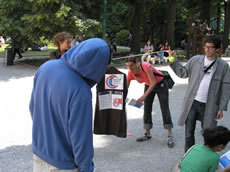
Le kiosque du Commons Service Group, conçu par public works. Commons
Service Group kiosk, conceptualized by public works. photo: Aaron
Schmidt
‡‡‡‡‡‡‡‡‡‡‡
We invite your participation:
www.ecoledumagasin.com/csg/wordpress/
The activities of the Commons Service Group continue. New projects will be published via our blog. The blog is an open blog and we invite you to participate!
Nous vous invitons à participer:
www.ecoledumagasin.com/csg/wordpress/
Les activités du Commons Service Group se poursuivent. De nouveaux projets seront publiés sur notre blog. Nous vous invitons à participer à ce blog ouvert à tous !